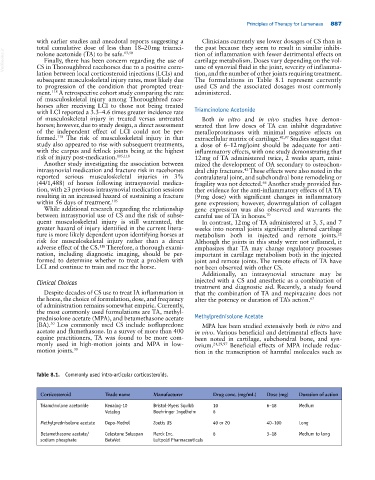Page 921 - Adams and Stashak's Lameness in Horses, 7th Edition
P. 921
Principles of Therapy for Lameness 887
with earlier studies and anecdotal reports suggesting a Clinicians currently use lower dosages of CS than in
total cumulative dose of less than 18–20 mg triamci- the past because they seem to result in similar inhibi-
VetBooks.ir CS in Thoroughbred racehorses due to a positive corre- cartilage metabolism. Doses vary depending on the vol-
tion of inflammation with fewer detrimental effects on
nolone acetonide (TA) to be safe.
13,50
Finally, there has been concern regarding the use of
ume of synovial fluid in the joint, severity of inflamma-
lation between local corticosteroid injections (LCIs) and tion, and the number of other joints requiring treatment.
subsequent musculoskeletal injury rates, most likely due The formulations in Table 8.1 represent currently
to progression of the condition that prompted treat- used CS and the associated dosages most commonly
ment. A retrospective cohort study comparing the rate administered.
118
of musculoskeletal injury among Thoroughbred race-
horses after receiving LCI to those not being treated
with LCI reported a 3.3–4.6 times greater incidence rate Triamcinolone Acetonide
of musculoskeletal injury in treated versus untreated Both in vitro and in vivo studies have demon-
horses; however, due to study design, a direct assessment strated that low doses of TA can inhibit degradative
of the independent effect of LCI could not be per- metalloproteinases with minimal negative effects on
formed. The risk of musculoskeletal injury in that extracellular matrix of cartilage. 42,97 Studies suggest that
118
study also appeared to rise with subsequent treatments, a dose of 6–12 mg/joint should be adequate for anti‐
with the carpus and fetlock joints being at the highest inflammatory effects, with one study demonstrating that
risk of injury post‐medication. 105,118 12 mg of TA administered twice, 2 weeks apart, mini-
Another study investigating the association between mized the development of OA secondary to osteochon-
intrasynovial medication and fracture risk in racehorses dral chip fractures. These effects were also noted in the
42
reported serious musculoskeletal injuries in 3% contralateral joint, and subchondral bone remodeling or
(44/1,488) of horses following intrasynovial medica- fragility was not detected. Another study provided fur-
66
tion, with ≥3 previous intrasynovial medication sessions ther evidence for the anti‐inflammatory effects of IA TA
resulting in an increased hazard of sustaining a fracture (9 mg dose) with significant changes in inflammatory
within 56 days of treatment. 105 gene expression; however, downregulation of collagen
While additional research regarding the relationship gene expression was also observed and warrants the
between intrasynovial use of CS and the risk of subse- careful use of TA in horses. 70
quent musculoskeletal injury is still warranted, the In contrast, 12 mg of TA administered at 3, 5, and 7
greater hazard of injury identified in the current litera- weeks into normal joints significantly altered cartilage
ture is more likely dependent upon identifying horses at metabolism both in injected and remote joints.
22
risk for musculoskeletal injury rather than a direct Although the joints in this study were not inflamed, it
adverse effect of the CS. Therefore, a thorough exami- emphasizes that TA may change regulatory processes
118
nation, including diagnostic imaging, should be per- important in cartilage metabolism both in the injected
formed to determine whether to treat a problem with joint and remote joints. The remote effects of TA have
LCI and continue to train and race the horse. not been observed with other CS.
Additionally, an intrasynovial structure may be
Clinical Choices injected with a CS and anesthetic as a combination of
treatment and diagnostic aid. Recently, a study found
Despite decades of CS use to treat IA inflammation in that the combination of TA and mepivacaine does not
the horse, the choice of formulation, dose, and frequency alter the potency or duration of TA’s action. 67
of administration remains somewhat empiric. Currently,
the most commonly used formulations are TA, methyl-
prednisolone acetate (MPA), and betamethasone acetate Methylprednisolone Acetate
(BA). Less commonly used CS include isoflupredone MPA has been studied extensively both in vitro and
30
acetate and flumethasone. In a survey of more than 400 in vivo. Various beneficial and detrimental effects have
equine practitioners, TA was found to be more com- been noted in cartilage, subchondral bone, and syn-
monly used in high‐motion joints and MPA in low‐ ovium. 21,29,97 Beneficial effects of MPA include reduc-
motion joints. 30 tion in the transcription of harmful molecules such as
Table 8.1. Commonly used intra‐articular corticosteroids.
Corticosteroid Trade name Manufacturer Drug conc. (mg/mL) Dose (mg) Duration of action
Triamcinolone acetonide Kenalog‐10 Bristol‐Myers Squibb 10 6–18 Medium
Vetalog Boehringer Ingelheim 6
Methylprednisolone acetate Depo‐Medrol Zoetis US 40 or 20 40–100 Long
Betamethasone acetate/ Celestone Soluspan Merck Inc. 6 3–18 Medium to long
sodium phosphate BetaVet Luitpold Pharmaceuticals

